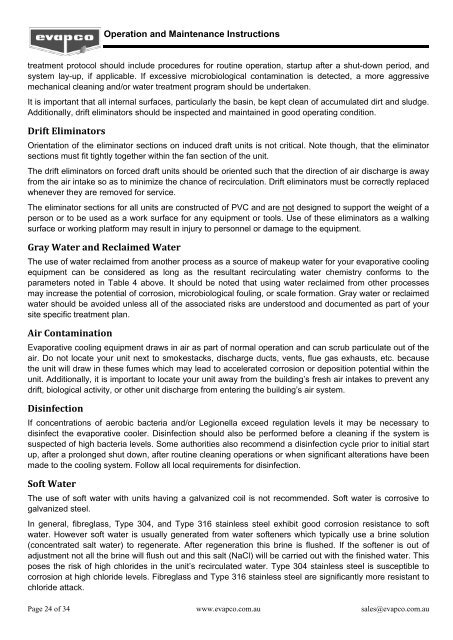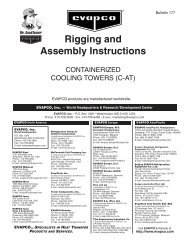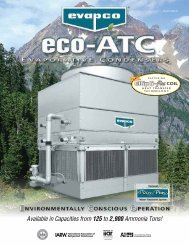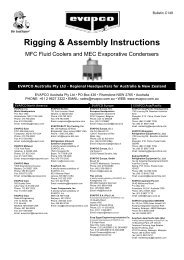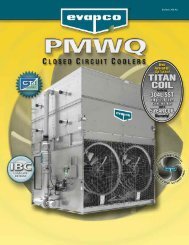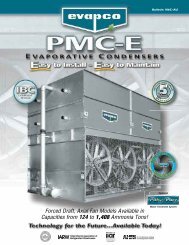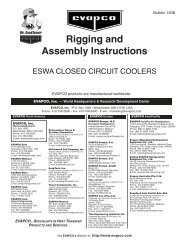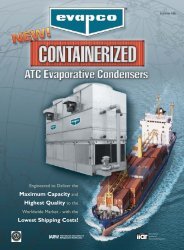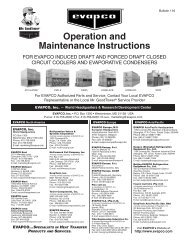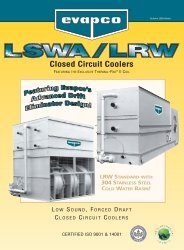For Evapco Fibreglass Cooling Towers, Closed ... - EVAPCO.com.au
For Evapco Fibreglass Cooling Towers, Closed ... - EVAPCO.com.au
For Evapco Fibreglass Cooling Towers, Closed ... - EVAPCO.com.au
You also want an ePaper? Increase the reach of your titles
YUMPU automatically turns print PDFs into web optimized ePapers that Google loves.
Operation and Maintenance Instructions<br />
treatment protocol should include procedures for routine operation, startup after a shut-down period, and<br />
system lay-up, if applicable. If excessive microbiological contamination is detected, a more aggressive<br />
mechanical cleaning and/or water treatment program should be undertaken.<br />
It is important that all internal surfaces, particularly the basin, be kept clean of accumulated dirt and sludge.<br />
Additionally, drift eliminators should be inspected and maintained in good operating condition.<br />
Drift Eliminators<br />
Orientation of the eliminator sections on induced draft units is not critical. Note though, that the eliminator<br />
sections must fit tightly together within the fan section of the unit.<br />
The drift eliminators on forced draft units should be oriented such that the direction of air discharge is away<br />
from the air intake so as to minimize the chance of recirculation. Drift eliminators must be correctly replaced<br />
whenever they are removed for service.<br />
The eliminator sections for all units are constructed of PVC and are not designed to support the weight of a<br />
person or to be used as a work surface for any equipment or tools. Use of these eliminators as a walking<br />
surface or working platform may result in injury to personnel or damage to the equipment.<br />
Gray Water and Reclaimed Water<br />
The use of water reclaimed from another process as a source of makeup water for your evaporative cooling<br />
equipment can be considered as long as the resultant recirculating water chemistry conforms to the<br />
parameters noted in Table 4 above. It should be noted that using water reclaimed from other processes<br />
may increase the potential of corrosion, microbiological fouling, or scale formation. Gray water or reclaimed<br />
water should be avoided unless all of the associated risks are understood and documented as part of your<br />
site specific treatment plan.<br />
Air Contamination<br />
Evaporative cooling equipment draws in air as part of normal operation and can scrub particulate out of the<br />
air. Do not locate your unit next to smokestacks, discharge ducts, vents, flue gas exh<strong>au</strong>sts, etc. bec<strong>au</strong>se<br />
the unit will draw in these fumes which may lead to accelerated corrosion or deposition potential within the<br />
unit. Additionally, it is important to locate your unit away from the building’s fresh air intakes to prevent any<br />
drift, biological activity, or other unit discharge from entering the building’s air system.<br />
Disinfection<br />
If concentrations of aerobic bacteria and/or Legionella exceed regulation levels it may be necessary to<br />
disinfect the evaporative cooler. Disinfection should also be performed before a cleaning if the system is<br />
suspected of high bacteria levels. Some <strong>au</strong>thorities also re<strong>com</strong>mend a disinfection cycle prior to initial start<br />
up, after a prolonged shut down, after routine cleaning operations or when significant alterations have been<br />
made to the cooling system. Follow all local requirements for disinfection.<br />
Soft Water<br />
The use of soft water with units having a galvanized coil is not re<strong>com</strong>mended. Soft water is corrosive to<br />
galvanized steel.<br />
In general, fibreglass, Type 304, and Type 316 stainless steel exhibit good corrosion resistance to soft<br />
water. However soft water is usually generated from water softeners which typically use a brine solution<br />
(concentrated salt water) to regenerate. After regeneration this brine is flushed. If the softener is out of<br />
adjustment not all the brine will flush out and this salt (NaCl) will be carried out with the finished water. This<br />
poses the risk of high chlorides in the unit’s recirculated water. Type 304 stainless steel is susceptible to<br />
corrosion at high chloride levels. <strong>Fibreglass</strong> and Type 316 stainless steel are significantly more resistant to<br />
chloride attack.<br />
Page 24 of 34 www.evapco.<strong>com</strong>.<strong>au</strong> sales@evapco.<strong>com</strong>.<strong>au</strong>


